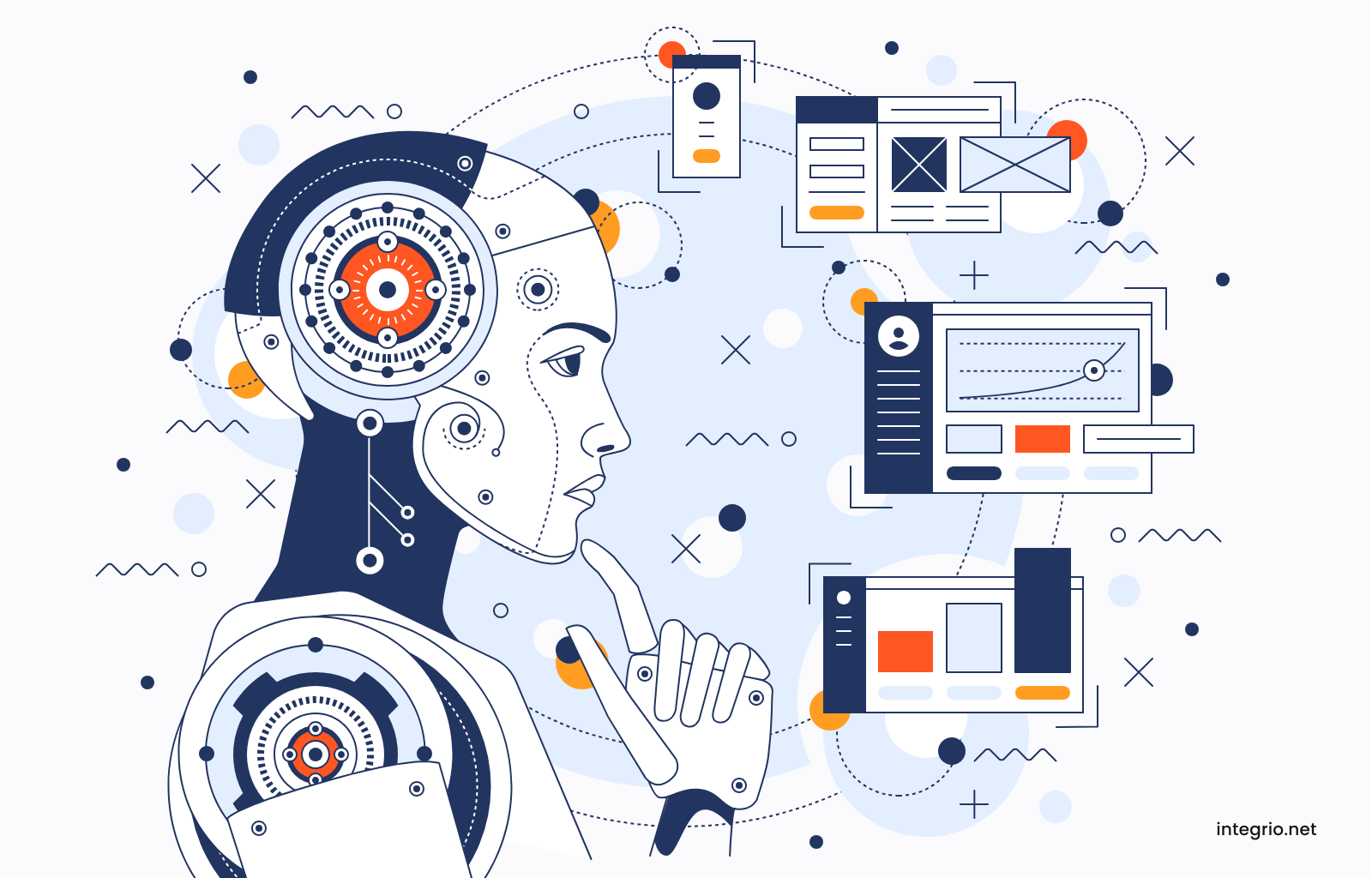Cost of AI Development: Examples and Integration Process

Increasingly fewer businesses keep asking, “Should we invest in AI?” Instead, they focus on “How much does AI development cost?” or, rather, “How do we invest in AI without breaking the bank?” The difference in approach separates companies that build competitive advantages from those that burn through budgets on flashy tech demos.
When you know what creates expenses in AI development, you can control them. And when you can control them, you can build AI systems that deliver ROI instead of bills. So, let’s take a look at real-world AI project examples to clarify it all.
First Example: AI for Customer Support Automation
An AI chatbot handles routine inquiries without human intervention by using natural language processing (NLP). It interprets customer questions, accesses relevant databases, and provides accurate responses in real-time. Modern chatbots understand context, handle follow-ups, escalate complex issues, and learn from interactions to improve over time.
AI development pricing examples for such a solution typically range from $30,000 to $60,000. Several factors can affect the cost:
- NLP complexity. Basic intent recognition costs less than advanced capabilities, such as sentiment analysis and multilingual support. The difference determines whether your bot handles simple questions or manages complex, multipart conversations.
- Integration depth. Surface-level integrations cost significantly less than deep connections with your customer management tools. The ability to modify orders or process refunds requires additional integrations, which necessitate an extra level of functionality and security implementation.
- Customization requirements. Pre-built templates keep costs down but limit functionality. Custom interfaces, personalized flows, and specialized reporting add extra expenses but create differentiated customer experiences and provide richer insights for your team.
After implementing these chatbots, companies see a significant reduction in tier-one support tickets within months. Artificial intelligence provides 24/7 availability, handles volume spikes instantly, and generates actionable data about customer pain points.
Second Example: AI-Powered Demand Forecasting for Retailers
A forecasting system analyzes multiple data streams to predict product demand with remarkable accuracy. It assesses historical sales data, seasonal patterns, promotional campaign results, and external factors such as weather changes, economic indicators, and market trends to identify subtle correlations and generate precise demand predictions.
The approximate cost range for such systems is from $50,000 to $120,000. The factors influencing the price of developing AI include:
- Data complexity and volume. Systems analyzing basic sales history cost less than those processing weather data, social media trends, etc. Each additional data source increases development costs but significantly improves prediction accuracy.
- Integration requirements. Connecting to existing ERP, POS, and warehouse management systems requires custom API development. Integrations add to the price tag, but they create automated workflows that eliminate manual processes.
- Prediction granularity. Store-level forecasting costs less than SKU-level predictions across multiple locations. Yet, advanced granularity (predicting demand by customer clusters, location, and period) enables precise inventory optimization.
- Real-time processing. Basic batch processing systems cost less than real-time forecasting that adjusts predictions as new data arrives. While more expensive to implement, real-time insights enable immediate market response.
By integrating with ERP and sales platforms, the system automatically triggers purchase orders, adjusts inventory levels, and alerts managers to potential supply chain disruptions before they impact sales. AI software for retailers frees up substantial working capital, reduces storage costs, and directly translates to increased sales and customer satisfaction.
Third Example: Custom AI Recommendation Engine for E-Commerce
A recommendation engine analyzes customer behavior, purchase history, and product data to deliver personalized product suggestions. The system tracks user interactions—clicks, views, cart additions, and purchases—to build individual preference profiles that improve with each customer action. It delivers suggestions through multiple touchpoints: homepage displays, product detail pages, email campaigns, and checkout upsells.
In this case, the AI project cost will be around $40,000–$90,000 due to the following factors:
- Scalability considerations. Systems designed for thousands of products and customers require different architectures than those managing several stock keeping units and millions of users.
- Data requirements. The system needs comprehensive product information, such as categories, attributes, pricing, availability, and detailed customer interaction data. Data volumes and quality directly influence the setup and refinement cost.
- Integration complexity. Recommendation engines may require connections with one or multiple systems, such as e-commerce platforms for product catalogs and customer data, email marketing tools for personalized campaigns, analytics platforms for performance tracking, and inventory systems for real-time availability, among others.
Personalized recommendations drive higher customer engagement, as users spend more time on a website and view more products per session. The technology excels particularly in cross-selling and upselling, helping customers discover relevant products they might otherwise overlook. It all means significant improvements in customer lifetime value.
Process of Integrating AI into Existing Systems
Successfully integrating AI into existing business systems requires a systematic approach that balances technical requirements with operational realities. To sum up the AI development process in a brief roadmap:
Assess current infrastructure and data readiness. Evaluate existing systems, data quality, and technical capabilities. Analyze data formats, storage capacity, processing power, and integration points.
Collaborate with AI and machine learning specialists. Partner with experienced AI developers who understand both the technology and your industry requirements. It’ll help you avoid common pitfalls and technical debt.
Define clear goals and KPIs for AI adoption. Establish measurable objectives that align AI capabilities with business outcomes. Specific targets like “reduce customer response time by 40%” provide clear success metrics.
Select appropriate AI models and tools. Choose AI technologies that match your use case rather than adopting the latest trends. That’s the best way to balance functionality, cost, and maintenance requirements while integrating it smoothly.
Pilot the solution and gather feedback. Implement AI in a controlled environment before full deployment to identify issues. Pilot programs reveal integration challenges, user adoption barriers, and performance gaps.
Train staff and update workflows. Prepare employees for AI-enhanced processes. Provide targeted training and clear workflow documentation. Change management is as important as technical implementation.
Monitor performance and iterate. Continuously track the performance of your AI system against established KPIs. Adjust algorithms, processes, and integrations based on real-world usage patterns.
The integration process typically spans several months. It’s best to approach it as a business transformation project rather than a simple technology upgrade. Make sure that human and technical elements work together effectively.
Conclusion
Understanding AI development cost gives you the control needed to build systems that deliver ROI instead of bills. Whether you’re starting with a basic customer support chatbot or planning a complex forecasting system, the same principles apply: clear objectives, realistic budgeting, and systematic integration.
Your AI-driven competitive advantage starts with making informed investment decisions. Now you have the framework to evaluate costs, plan integration, and build AI systems that transform operations rather than drain resources. If you’re ready to add the final piece to this puzzle—a reliable AI development partner—contact Integrio, and let’s discuss it.
FAQ
The timelines vary significantly based on project complexity and integration requirements. Customer support chatbots typically take 2–4 months from concept to deployment. Complex recommendation engines can span beyond 8 months. It depends on your requirements and tech stack.
Data quality tops the list of challenges. Many businesses discover that their existing data is incomplete, inconsistent, or stored in incompatible formats. Another major concern is legacy systems. Old software may lack the needed APIs or integration capabilities. Finally, there’s a project size factor; the more complex and feature-rich the system you need, the more bottlenecks an AI development team can have.
Look for partners with proven experience in your industry who have worked with similar use cases. Request detailed case studies and client references from similar projects. Assess both technical capabilities and approach to project management and communication. Don’t hesitate to request an approximate cost breakdown of AI development for your case.
Healthcare, fintech, e-commerce, retail, and manufacturing are currently among the leaders. Yet, investment levels often reflect industry size rather than the success of AI adoption. Sectors like agriculture and energy are also seeing rapid AI growth. Opportunities exist across all industries if businesses are ready to implement AI strategically.
Contact us

